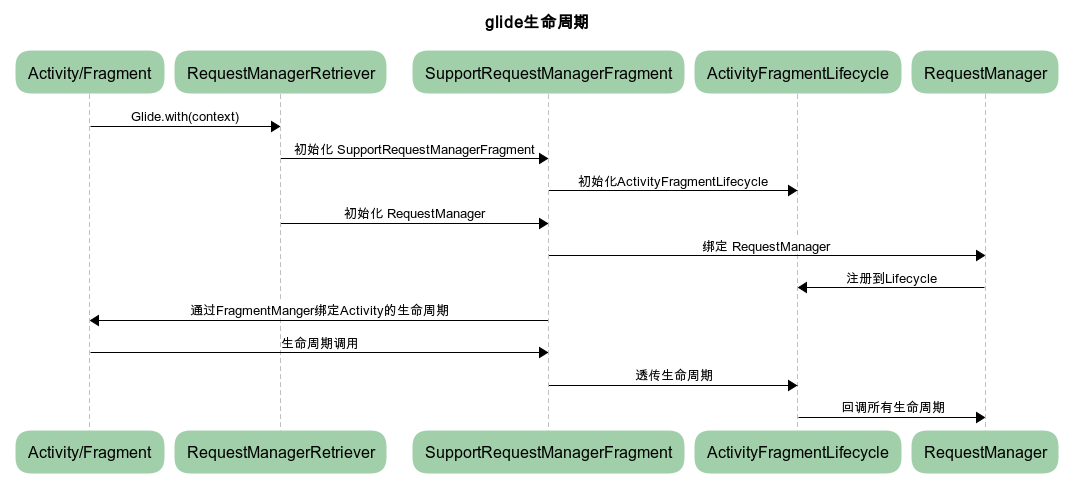Glide(1) Lifecycle Binding
Posted by luke_barnes on Thu, 18 Jun 2020 18:09:43 +0200
Glide.with(FragmentActivity activity)
public static RequestManager with(Activity activity) {
return getRetriever(activity).get(activity);
}
public RequestManager get(Activity activity) {
if (Util.isOnBackgroundThread()) {
return get(activity.getApplicationContext());
} else {
assertNotDestroyed(activity);
android.app.FragmentManager fm = activity.getFragmentManager();
return fragmentGet(activity, fm, null );
}
}
- 1.2 See RequestManagerFragment here
private RequestManager fragmentGet(Context context, android.app.FragmentManager fm,
android.app.Fragment parentHint) {
// a. Bind RequestManager Fragment to Fragment Manager to synchronize RequestManager Fragment lifecycle activities
RequestManagerFragment current = getRequestManagerFragment(fm, parentHint)
RequestManager requestManager = current.getRequestManager()
if (requestManager == null) {
// TODO(b/27524013): Factor out this Glide.get() call.
Glide glide = Glide.get(context)
requestManager =
// b. Get an instance of RequestManager and give the current RequestManager Fragment
factory.build(glide, current.getGlideLifecycle(), current.getRequestManagerTreeNode())
current.setRequestManager(requestManager)
}
return requestManager
}
- 1.3 Bind RequestManager Fragments to FragmentManager, and RequestManager Fragments currently have their life cycle and see how to implement it
@TargetApi(Build.VERSION_CODES.JELLY_BEAN_MR1)
RequestManagerFragment getRequestManagerFragment(
final android.app.FragmentManager fm, android.app.Fragment parentHint) {
//a. Get RequestManagerFragment instances based on TAG id
RequestManagerFragment current = (RequestManagerFragment) fm.findFragmentByTag(FRAGMENT_TAG)
if (current == null) {
// b. If a does not get an instance, get it from the map in memory
current = pendingRequestManagerFragments.get(fm)
if (current == null) {
// c. None of the above a or B fetches an instance, then the last new one is put into the memory map
current = new RequestManagerFragment()
current.setParentFragmentHint(parentHint)
pendingRequestManagerFragments.put(fm, current)
// Fragments are bound to FragmentManager, so RequestManager Fragments have a life cycle
fm.beginTransaction().add(current, FRAGMENT_TAG).commitAllowingStateLoss()
handler.obtainMessage(ID_REMOVE_FRAGMENT_MANAGER, fm).sendToTarget()
}
}
return current
}
- 1.4 Reference to action b in step 1.2 above causes RequestManager in RequestManager Fragment, which adds itself to Lifecycle in construction
RequestManager(
Glide glide,
Lifecycle lifecycle,
RequestManagerTreeNode treeNode,
RequestTracker requestTracker,
ConnectivityMonitorFactory factory) {
this.glide = glide;
this.lifecycle = lifecycle;
this.treeNode = treeNode;
this.requestTracker = requestTracker;
...
if (Util.isOnBackgroundThread()) {
mainHandler.post(addSelfToLifecycle);
} else {
lifecycle.addListener(this);
}
lifecycle.addListener(connectivityMonitor);
setRequestOptions(glide.getGlideContext().getDefaultRequestOptions());
glide.registerRequestManager(this);
}
private final Runnable addSelfToLifecycle = new Runnable() {
@Override
public void run() {
lifecycle.addListener(RequestManager.this);
}
};
- 2.1 Transfer of Fragment lifecycle
public RequestManagerFragment() {
this(new ActivityFragmentLifecycle());
}
@SuppressLint("ValidFragment")
RequestManagerFragment(ActivityFragmentLifecycle lifecycle) {
this.lifecycle = lifecycle;
}
@Override
public void onStart() {
super.onStart();
lifecycle.onStart();
}
@Override
public void onStop() {
super.onStop();
lifecycle.onStop();
}
@Override
public void onDestroy() {
super.onDestroy();
lifecycle.onDestroy();
unregisterFragmentWithRoot();
}
- 2.2 Callback all lifecycle interfaces
- RequestManager Fragment calls back all registered RequestManagers
@Override
public void removeListener(LifecycleListener listener) {
lifecycleListeners.remove(listener);
}
void onStart() {
isStarted = true;
for (LifecycleListener lifecycleListener : Util.getSnapshot(lifecycleListeners)) {
lifecycleListener.onStart();
}
}
void onStop() {
isStarted = false;
for (LifecycleListener lifecycleListener : Util.getSnapshot(lifecycleListeners)) {
lifecycleListener.onStop();
}
}
void onDestroy() {
isDestroyed = true;
for (LifecycleListener lifecycleListener : Util.getSnapshot(lifecycleListeners)) {
lifecycleListener.onDestroy();
}
}
}
summary
- 1. Bind an empty RequestManager Fragment to synchronize the Activity lifecycle by getting the Fragment Manager of the Activity
- 2. Initialize LifecycleListener in RequestManagerFragment
- 3. Initialize RequestManager Fragment, colleague initialize RequestManager, and register with Lifecycle Listener
- 4. When an activity triggers a life cycle, calls back Fragment and passes it to Lifecycle Listener, which calls back all RequestManager s registered with it
- All in all, the new decoupling skills.Time Series Graph Offered

Topics:
Fragment
Android
